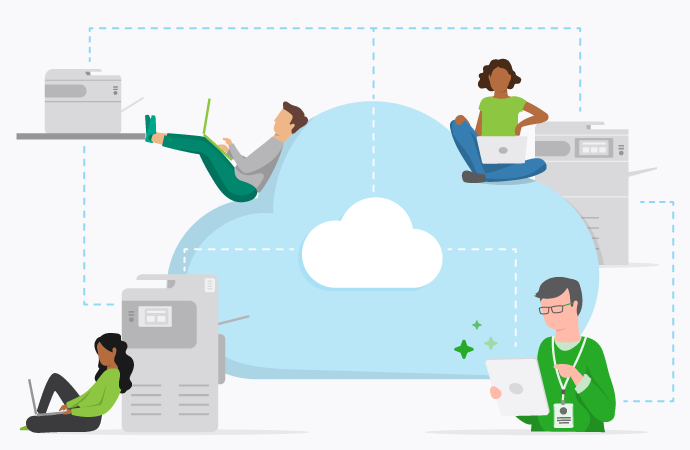Remote work means we can work from anywhere. But for a long time, even with the advent of home Wi-Fi and secure cloud-based networks, printing a physical document usually meant you had to be standing at an actual printer.
This was a drag. Not just for the people forced to commute simply to print, but from a business efficiency perspective, too. There was no central, easy way to manage print mobility and remote printing, no way to quickly roll-out drivers and security updates across a large network, no way to handle BYOD collaboration, or ditch old-school print servers.
Well, those days are officially over. Cloud print management and remote work solutions have fundamentally changed the way organizations handle documents – and people. This tech is trending up. Today, 70% of companies run more than half their workflow through the cloud, and cloud print adoption is expected to hit 55% by 2025.
So, let’s explore cloud print management, and how you can use it to speed up your organization.
Print mobility has arrived
For years, print mobility was the missing piece in the remote work solution puzzle. Employees still needed to handle physical documents, and there wasn’t an easy or secure way for jobs to be logged remotely, especially on BYO devices. That’s all changed now. In a post-COVID world, remote work platforms are commonplace, and organizations are looking for tech that will allow users to do anything they can do on-site – including printing.
Benefits of cloud print management for remote working
Remote work solutions are all about two things: flexibility and security. Get those right and everything else falls into place. Luckily, cloud print management helps facilitate both secure printing and office flexibility. So, you get the best of both worlds.
Print from anywhere. If you have an internet connection and a compatible printer, the world is your oyster. That’s the beauty of cloud print. Diverse organizations can now print their documents from home, coworking spaces, or any location with internet access. This gives businesses a huge amount of flexibility.
Device agnostic. Cloud print management is usually device agnostic (and if it isn’t, find a new provider). That means it works with basically any device, including cell phones, tablets, laptops, and desktops. All you need is an internet connection.
Ditch the VPN. Traditional printing setups had some remote capabilities, but they were usually built around clunky Virtual Private Networks (VPNs). Cloud printing doesn’t need a VPN, which simplifies the whole process for remote employees.
Integration with cloud storage. Cloud printing also integrates seamlessly with cloud storage services like Google Drive, Dropbox, and Microsoft OneDrive. Remote workers can now access, proof and print their documents, without ever leaving the cloud. No more local file transfers!
Centralized print management. Cloud print management is all about centralizing control. Done correctly, it gives your IT managers one place where they can track trends, printer usage, consumable levels, printer data, access controls, and device settings. This, in turn, reduces the burden on IT. Always a good thing.
Security. Your first thought when you hear ‘cloud printing’ might be ‘security risk’. But that’s only true if it’s implemented poorly. Cloud based print management, like PaperCut, comes with end-to-end WebRTC encryption , so your print metadata is safe and sound.
Remote printing challenges
Remote printing has opened up a new era of work, but it does come with certain drawbacks. These aren’t deal breakers, necessarily, and most of them can be alleviated with the right systems in place. But they’re worth mentioning all the same:
Internet dependency. There’s no getting around it. The internet is cloud printing’s greatest strength, and its Achilles heel. If the internet goes down, so does your remote print capability.
Security concerns. Transmitting sensitive print jobs over the cloud is serious business, which is why most cloud print management solutions use some combination of end-to-end-encryption, user authentication, secure print release and biometric credentials.
Data privacy and compliance. If you’re working in a regulated industry, like healthcare or finance, there will likely be strict laws about how you use the cloud. Organizations must be on top of this stuff and choose cloud print solutions that comply with any relevant legislation .
User training. Transitioning a large organization to the cloud is always a challenge, particularly if people have been using legacy systems for a long time. Printing is no different. Most people agree that cloud-based solutions are easier all-round, but you’ll probably need to invest some time and energy into training to facilitate a smooth upgrade.
Customize your settings
One of the real perks of a robust cloud print management solution is that you can customize individual users’ print settings. In other words, total granular control for your IT managers. Users can have assigned print limits, print budgets, or different security clearance levels, depending on the needs of the organization.
Remote work and productivity
Ahh, the lazy, undisciplined elephant in the room. No matter how many studies (and there are many) show that remote work improves employee productivity, 85% of business leaders believe the opposite. It feels like an irreconcilable difference that will have to be reconciled, if remote/hybrid work is going to have any chance at survival.
For now, it’s worth noting that remote printing definitely boosts worker productivity, if only because people can now accomplish more work in less time. Just another reason to make the jump to the cloud.
Ready to transition your print environment to the cloud? Don’t worry, it’s much easier than it sounds. Get in touch with our friendly team, and we’ll walk you through the process.


